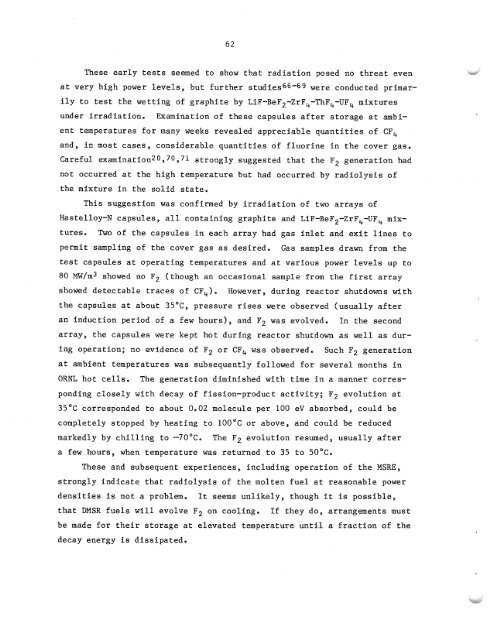ORNL-TM-7207 - the Molten Salt Energy Technologies Web Site
ORNL-TM-7207 - the Molten Salt Energy Technologies Web Site
ORNL-TM-7207 - the Molten Salt Energy Technologies Web Site
You also want an ePaper? Increase the reach of your titles
YUMPU automatically turns print PDFs into web optimized ePapers that Google loves.
62<br />
These early tests seemed to show that radiation posed no threat even<br />
at very high power levels, but fur<strong>the</strong>r studies66-69 were conducted primar-<br />
ily to test <strong>the</strong> wetting of graphite by LiF-BeP2-ZrFq-ThF4-UPq mixtures<br />
under irradiation.<br />
ent temperatures for many weeks revealed appreciable quantities of CF4<br />
and, in most cases, considerable quantities of fluorine in <strong>the</strong> cover gas.<br />
Careful e~mination20~70~71 strongly suggested that <strong>the</strong> p2 generation had<br />
not occurred at <strong>the</strong> high temperature but had occurred by radiolysis of<br />
<strong>the</strong> mixture in <strong>the</strong> solid state.<br />
Examination of <strong>the</strong>se capsules after storage at mbi-<br />
This suggestion was confirmed by irradiation of two arrays sf<br />
Nastelloy-M capsules, all containing graphite and LiF-BeF2-ZrF4-UF4 mix-<br />
tures. Two of <strong>the</strong> capsules in each array had gas inlet and exit lines to<br />
permit sampling of <strong>the</strong> cover gas as desired.<br />
Gas samples dram from <strong>the</strong><br />
test capsules at operating temperatures and at various power levels up to<br />
80 m/m3 showed H~Q F~ (though an occasional sample from <strong>the</strong> first array<br />
showed detectable traces of CF,). However, during reactor shutdowns with<br />
<strong>the</strong> capsules at about 3%"6, pressure rises were observed (usually after<br />
an induction period of a few Bmours), and F2 was evolved. In <strong>the</strong> second<br />
array, <strong>the</strong> capsules were kept hot during reactor shutdown as well as Bur-<br />
i~lg operation; BO evidence of F~ or CF, was observed. such -17~ generation<br />
at ambient temperatures was subsequently followed for several months in<br />
OREaE hot cells.<br />
The generation diminished with time in a manner corres-<br />
ponding closely with decay of fission-produet activity; F2 evolution at<br />
35°C corresponded t~ about 0,02 molecule per 188 eV absorbed, eodd be<br />
Completely stopped by heating to I.OO"C or above, and could be resfu~ed<br />
markedly by chililing to -7O"C. The F2 e~slution resumed, usualI~ after<br />
a few hours, when temperature was returned to 35 to 50"Ce<br />
These and subsequent experiences, including operation of <strong>the</strong> MSRE,<br />
strongly indicate that radfolysfs of <strong>the</strong> molten fuel at reasonable power<br />
densities is not a problem. It seems unlikely, though it is possible,<br />
that DMSR fuels will evolve F2 on coolit~g, If <strong>the</strong>y do, arrangements must<br />
be made for <strong>the</strong>ir storage at elevated temperature until a f~a~tion sf <strong>the</strong><br />
decay energy is dissipated.



![Review of Molten Salt Reactor Physics Calculations [Disc 2]](https://img.yumpu.com/21979492/1/190x247/review-of-molten-salt-reactor-physics-calculations-disc-2.jpg?quality=85)












